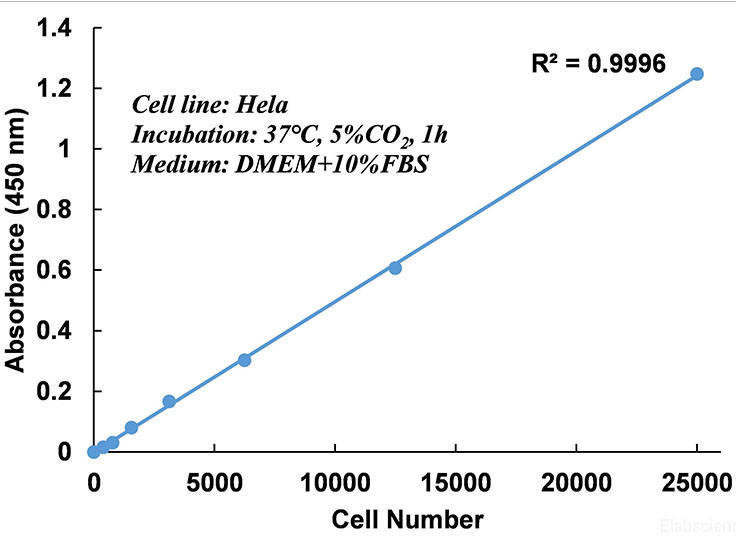3D Respiratory Organoids Cell Viability in a High-throughput 384-well Plate Assay
The Assay Genie 3D Organoid Cell Viability Assay (AKES081) provided superior results compared to ThermoScientific PrestoBlue, maintaining over 100% viability at all time points in untreated 3D apical-out airway organoids. AKES081 detected reduced cell viability (0.5% to 5.9%) when organoids were treated with 10% DMSO, demonstrating its ability to accurately measure cytotoxic effects. AKES081 maintained consistent and reliable readings across 1-hour, 3-hour, and overnight incubations, making it suitable for high-throughput and long-term studies. Unlike resazurin-based methods, the WST-8-based assay provided more stable results with minimal interference, allowing for extended incubation times without compromising cell viability measurements. AKES081 1-step, wash-free protocol makes it highly efficient for large-scale drug screening in 384-well plate formats, improving workflow efficiency in virology and organoid research.
Key Findings:
- The Assay Genie 3D Organoid Cell Viability Assay (AKES081) provided superior results compared to ThermoScientific PrestoBlue, maintaining over 100% viability at all time points in untreated 3D apical-out airway organoids.
- AKES081 detected reduced cell viability (0.5% to 5.9%) when organoids were treated with 10% DMSO, demonstrating its ability to accurately measure cytotoxic effects.
- AKES081 maintained consistent and reliable readings across 1-hour, 3-hour, and overnight incubations, making it suitable for high-throughput and long-term studies.
- Unlike resazurin-based methods, the WST-8-based assay provided more stable results with minimal interference, allowing for extended incubation times without compromising cell viability measurements.
- AKES081 1-step, wash-free protocol makes it highly efficient for large-scale drug screening in 384-well plate formats, improving workflow efficiency in virology and organoid research.
3D Respiratory Organoids Cell Viability in a High-throughput 384-well Plate Assay
Introduction
Airway infection is the 4th leading cause of death worldwide, primarily driven by viral infections. Apical-out respiratory organoids are innovative 3D models that mimic the human respiratory epithelium1. They can be used for various applications in the field of medical virology including analysing viral entry, virulence, cell pathogenesis, drug safety, immune response and even high-throughput drug screening studies.
However, due to the complex nature of organoids and 3D models, there remains a paucity of reagents capable of accurately measuring cell proliferation, viability, and cytotoxicity in these structures.
In this study, we show that the Assay Genie 3D Organoid Cell Viability Assay is an excellent reagent to measure cell viability in 3D respiratory organoids in a highthroughput 384-well format and gives far superior results to other leading reagents.
Assay Principle
The Assay Genie 3D Organoid Cell Viability Assay is a highly sensitive, 1-step kit to quantify the number of live viable cells directly in cell culture supernatants and 3D Organoid models.
This kit is an excellent choice for proliferation and cytotoxicity studies and been validated in 2D cell culture as well as Apical-Out airway organoids in a highthroughput 384-well format.
This technology is based on the reduction of WST-8 Tetrazolium salt by mitochondrial dehydrogenases to an orange product which is directly proportional to the number of viable cells when measured at 450nm.
WST-8 is highly soluble in cell culture medium with a low cytotoxicity profile and can be added directly to cultured cells with no pre-treatments or wash steps. It is extremely powerful for high-throughput and sensitive experiments especially those requiring longer incubation steps such as 24 hour or 48 hours.
This kit offers a much higher sensitivity and lower cytotoxicity than other Tetrazolium reagents such as MTS, MTT, PrestoBlue or XTT.
Materials & Methods
Multimode reader
384-w dark plate with clear bottom Corning®
DMSO (Sigma)
Protocol
- 75 to 100/well home-made apical out organoids (bronchial cells from a single donor to generate the respiratory organoids) were dispensed into a 384w plate in triplicate
- 0.1% and 10% DMSO were added as negative and positive controls in a final volume of 50µl
- The plate was incubated for 2 days at 37°C with 5% CO2
- 5µl of 3D Organoid Cell Viability Assay CCK8 buffer or Prestoblue reagent was added to each well and incubated for either 1 hour, 3 hours or overnight
Page 1
- The absorbance of the wells containing the 3D Organoid Cell Viability Assay CCK-8 buffer was measured at 490nm while those containing PrestoBlue reagent at ex 535nm/em 595nm
- Cell viability (%) was calculated from OD sample, control and blank.
Results & Discussion
Table 1: Dataset obtained with Spectra

A) 3D Apical-out organoids were treated with 0.1% DMSO and cell viability measured with either Assay Genie 3D Organoid Cell Viability Assay or the ThermoScientific PrestoBlue reagent after 1h, 3h and overnight incubations. Cell viability obtained with the 3D Organoid Cell Viability Assay on the organoids was above 100% at all time-points versus reduced viability when using PrestoBlue reagent.

B) 3D Apical-out organoids were treated with 10% DMSO to initiate cell death and viability was measured with either Assay Genie 3D Organoid Cell Viability Assay or ThermoScientific PrestoBlue reagent after 1h, 3h and overnight incubations. Cell viability obtained with the 3D Organoid Cell Viability Assay on the organoids detected reduced viability ranging from 0.5% to 5.9%.
Conclusion
The 3D Organoid Cell Viability Assay gave excellent results for apical out airway 3D organoids cell viability, by comparison to another resazurin-based method.
References
1. Stroulios G, Brown T, Moreni G, et al. Apical-out airway organoids as a platform for studying viral infections and screening for antiviral drugs. Sci Rep. 2022;12(1):7673. Published 2022 May 10. doi:10.1038/s41598-022-11700- z
Page 2
Meet Some of the Genie Team!
Recent Posts
-
Trained Immunity: How Your Innate Immune System Learns and Remembers
For decades, immunologists believed that only adaptive immunity—the sophisticated system of T cells …3rd Dec 2025 -
Extracellular Vesicles in Neurodegenerative Disease: From Pathology to Therapeutic Potential
In the intricate landscape of the brain, cells constantly communicate, sending and receiving message …2nd Dec 2025 -
Spatial Transcriptomics: Mapping the Future of Medicine at Cellular Resolution
Spatial Transcriptomics: Mapping the Future of Medicine at Cellular Resolution Imagine being able t …2nd Dec 2025





















